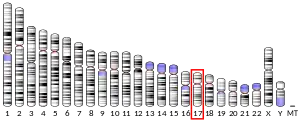CCDC40 is the gene in humans that encodes the protein named coiled-coil domain containing 40.[5]
Function
This gene encodes a protein that is necessary for motile cilia function. It functions in correct left-right axis formation by regulating the assembly of the inner dynein arm and the dynein regulatory complexes, which control ciliary beat. Mutations in this gene cause ciliary dyskinesia type 15, a disorder due to defects in cilia motility. Alternative splicing results in multiple transcript variants. [provided by RefSeq, Aug 2011].
References
- 1 2 3 GRCh38: Ensembl release 89: ENSG00000141519 - Ensembl, May 2017
- 1 2 3 GRCm38: Ensembl release 89: ENSMUSG00000039963 - Ensembl, May 2017
- ↑ "Human PubMed Reference:". National Center for Biotechnology Information, U.S. National Library of Medicine.
- ↑ "Mouse PubMed Reference:". National Center for Biotechnology Information, U.S. National Library of Medicine.
- ↑ "Entrez Gene: Coiled-coil domain containing 40".
Further reading
- Wang J, Lin J, Chang Y, Li P, Yang Y (August 2010). "MCM3AP, a novel HBV integration site in hepatocellular carcinoma and its implication in hepatocarcinogenesis". Journal of Huazhong University of Science and Technology. 30 (4): 425–9. doi:10.1007/s11596-010-0443-3. PMID 20714864. S2CID 195683753.
- Pagon RA, Adam MP, Ardinger HH, Wallace SE, Amemiya A, Bean LJ, Bird TD, Fong CT, Mefford HC, Smith RJ, Stephens K, Zariwala MA, Knowles MR, Leigh MW (1993). "Primary Ciliary Dyskinesia". PMID 20301301.
{{cite journal}}: Cite journal requires|journal=(help) - Blanchon S, Legendre M, Copin B, Duquesnoy P, Montantin G, Kott E, Dastot F, Jeanson L, Cachanado M, Rousseau A, Papon JF, Beydon N, Brouard J, Crestani B, Deschildre A, Désir J, Dollfus H, Leheup B, Tamalet A, Thumerelle C, Vojtek AM, Escalier D, Coste A, de Blic J, Clément A, Escudier E, Amselem S (June 2012). "Delineation of CCDC39/CCDC40 mutation spectrum and associated phenotypes in primary ciliary dyskinesia". Journal of Medical Genetics. 49 (6): 410–6. doi:10.1136/jmedgenet-2012-100867. PMID 22693285. S2CID 54524650.
- Becker-Heck A, Zohn IE, Okabe N, Pollock A, Lenhart KB, Sullivan-Brown J, McSheene J, Loges NT, Olbrich H, Haeffner K, Fliegauf M, Horvath J, Reinhardt R, Nielsen KG, Marthin JK, Baktai G, Anderson KV, Geisler R, Niswander L, Omran H, Burdine RD (January 2011). "The coiled-coil domain containing protein CCDC40 is essential for motile cilia function and left-right axis formation". Nature Genetics. 43 (1): 79–84. doi:10.1038/ng.727. PMC 3132183. PMID 21131974.
External links
- Human CCDC40 genome location and CCDC40 gene details page in the UCSC Genome Browser.
This article incorporates text from the United States National Library of Medicine, which is in the public domain.
This article is issued from Wikipedia. The text is licensed under Creative Commons - Attribution - Sharealike. Additional terms may apply for the media files.



